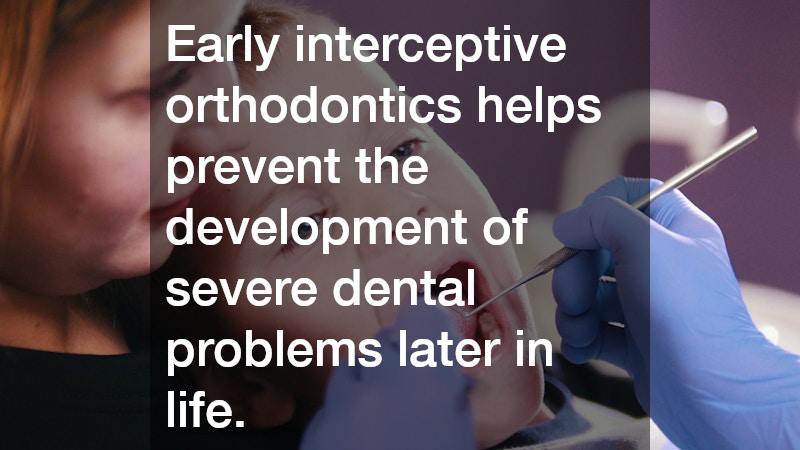
How Early Interceptive Orthodontics Can Prevent Future Dental Problems
Early interceptive orthodontics plays an essential role in setting the foundation for a healthy, properly aligned smile. By identifying and treating potential orthodontic issues in children before they worsen, this proactive approach helps reduce the need for complex dental procedures later in life. Guiding jaw growth, managing spacing, and correcting early bite irregularities all contribute to long-term oral health and confident smiles.
What Is Early Interceptive Orthodontics?
Definition and Purpose
Early interceptive orthodontics, also known as Phase One treatment, focuses on addressing developing dental and jaw problems in children between the ages of 6 and 10. Its primary goal is to guide proper growth and alignment during a child’s formative years. By treating issues such as crowding, bite irregularities, and jaw imbalances early, orthodontists can minimize or even eliminate the need for more extensive treatment in adolescence.
Age and Timing
Timing is one of the most important factors in early interceptive orthodontics. The American Association of Orthodontists recommends that children receive their first orthodontic evaluation by age seven. At this age, an orthodontist can identify growth patterns and dental concerns that may become more severe as the child matures. Intervening at the right time allows for gentle, effective guidance of jaw development and tooth eruption, reducing future complications.
Common Techniques
Several specialized techniques are used in early interceptive orthodontics to support natural development. Palatal expanders help widen the upper jaw to make room for permanent teeth, while space maintainers preserve gaps when baby teeth are lost prematurely. Limited braces or clear aligners may also be used to correct minor misalignments. Habit-breaking appliances can prevent thumb-sucking or tongue-thrusting, which often contribute to bite issues.
How Does Interceptive Orthodontics Help Prevent Future Dental Problems?
Addressing Misalignment and Bite Issues
Early interceptive orthodontics corrects bite problems such as overbites, underbites, and crossbites before they cause long-term damage. Misaligned bites can lead to uneven tooth wear, speech difficulties, and jaw discomfort. By guiding teeth and jaw growth during childhood, orthodontists can prevent these complications and promote a balanced, functional bite.
Crowding and Space Management
A common reason for early orthodontic treatment is crowding. When permanent teeth erupt into limited space, they may overlap or shift into improper positions. Interceptive orthodontics creates adequate space for new teeth to emerge correctly, reducing the need for extractions or braces later. Space maintainers and expanders help manage developing mouths to ensure proper alignment and spacing.
Long-Term Benefits on Oral Health
The long-term benefits of early interceptive orthodontics extend far beyond aesthetics. Proper alignment improves brushing and flossing efficiency, lowering the risk of cavities and gum disease. Children who undergo early treatment often experience better oral function, clearer speech, and improved confidence. By addressing structural issues early, orthodontists can promote a lifetime of easier maintenance and healthier smiles.
What Should Parents Consider When Pursuing Interceptive Orthodontics?
Evaluating Readiness and Need
Not every child requires early interceptive orthodontics, so determining readiness is key. Parents should look for warning signs such as early or late tooth loss, crowded or protruding teeth, mouth breathing, or difficulty chewing. A consultation with an orthodontist provides clarity on whether early intervention is necessary and what benefits it may bring.
Choosing the Right Orthodontist
Selecting a qualified orthodontist is essential for achieving optimal results. Parents should seek a professional who specializes in pediatric or interceptive orthodontic care and has experience with growing children. A good orthodontist will evaluate jaw development, discuss treatment options, and create a personalized plan that prioritizes comfort and long-term success.
Cost and Insurance Considerations
The cost of early interceptive orthodontics varies based on the complexity of the case and the type of appliances used. Many dental insurance plans cover a portion of the expenses, especially when treatment is deemed medically necessary. Families should ask about flexible payment plans and insurance options to make early orthodontic care more affordable.
Early interceptive orthodontics helps prevent the development of severe dental problems later in life. By addressing issues such as crowding, bite irregularities, and jaw imbalances during childhood, it lays the groundwork for a healthier, more confident smile. Timely evaluation, the right orthodontic plan, and consistent care can make a lasting difference in a child’s oral health and overall well-being.




